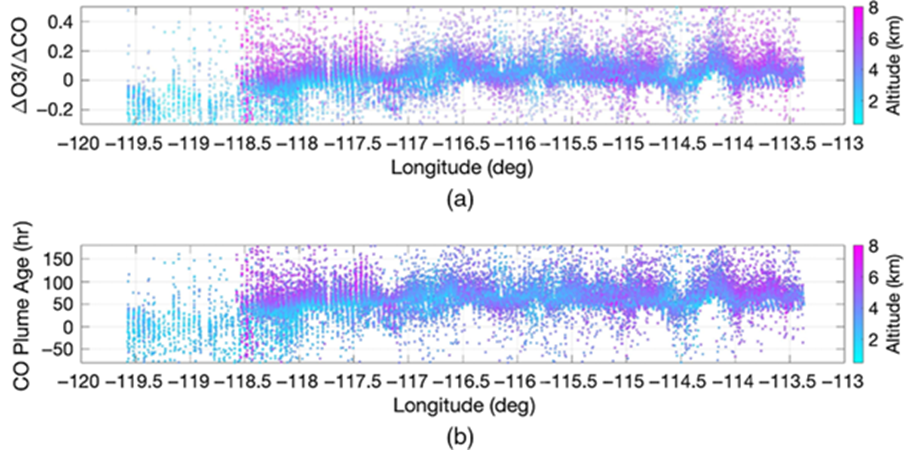Wildfires, marked by inadvertent, uncontrolled, and random fires breaking out in areas such as forests, prairies, and grasslands, have increased in intensity and frequency.
 (a) The distribution of ΔO3/ΔCO ratio along the longitude within the wildfire plume and (b) the estimated longitudinal CO plume age distribution based on the NAST-I measurements. Image Credit: The Authors - doi 10.1117/1.JRS.16.034522
(a) The distribution of ΔO3/ΔCO ratio along the longitude within the wildfire plume and (b) the estimated longitudinal CO plume age distribution based on the NAST-I measurements. Image Credit: The Authors - doi 10.1117/1.JRS.16.034522
Potentially caused by climate change effects, wildfires are progressively affecting ecosystems and the human race. Although wildfires are considered ecologically advantageous, there have been growing concerns over the negative impacts, namely a drop in air quality due to the pollutants and smoke emitted.
Ozone (O3) and carbon monoxide (CO) significantly contribute to wildfire-triggered air pollution. However, unlike CO, O3 is not directly produced during wildfires. Instead, it is generated from O3 precursors released during wildfires and relies on many factors for its creation. This, in turn, messes up the O3 generation process.
Furthermore, its existence within wildfire plumes establishes the wildfire plume age. Measuring its concentrations is, thus, essential to better comprehend how wildfires impact the weather, air quality, and climate.
In new research reported in SPIE’s Journal of Applied Remote Sensing, researchers at NASA Langley Research Center, in partnership with the National Oceanic and Atmospheric Administration (NOAA), illustrate their findings in this regard in the Fire Influence on Regional to Global Environments and Air Quality (FIREX-AQ) field campaigns in 2019.
The atmospheric O3 and CO level measurements were carried out across the continental USA with the help of a remote sensor called the “National Airborne Sounder Testbed-Interferometer” (NAST-I), which offered both high spectral and spatial resolution.
The NAST-I, onboard NASA ER-2 aircraft, covers a space large enough to monitor the wildfire plume from its origination, evolution, and transport, and provides 3D distributions of the O3 and CO concentrations at a higher spatial resolution compared to that of satellite infrared-ultraspectral sensors.
Dr Daniel K. Zhou, Principal Investigator of NAST-I and study lead author, NASA Langley Research Center
According to these measurements, the researchers estimated the plume age by monitoring the differential concentration ratios of O3 and CO, i.e., ΔO3/ΔCO, and carrying out a linear fit with earlier observations of wildfire ΔO3/ΔCO ratios.
Our results showed enhanced levels of CO in the evolving plume as it was transported away from the site of the fire. The plume age was associated with the plume distance in both vertical and horizontal directions.
Dr Daniel K. Zhou, Principal Investigator of NAST-I and study lead author, NASA Langley Research Center
This research offers crucial insights that could be vital in understanding the effects of wildfires on the atmosphere more profoundly and the steps required to alleviate them.
Journal Reference:
Zhou, K. D., et al. (2022) Estimation of fire-induced CO plume age from NAST–I during the FIREX-AQ field campaign. Journal of Applied Remote Sensing. doi.org/ 10.1117/1.JRS.16.034522.